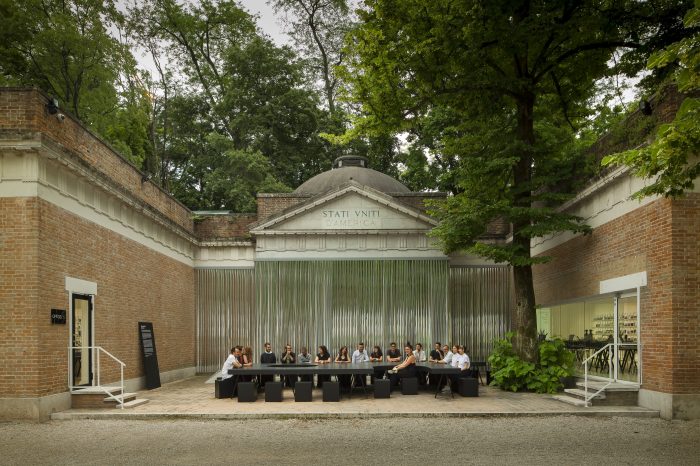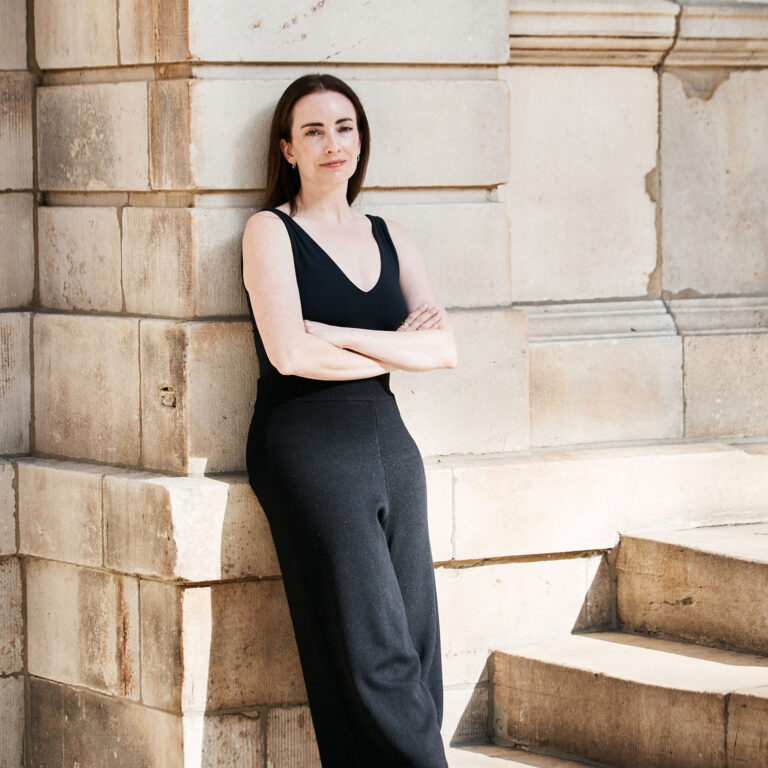
Eva Franch i Gilabert, chief curator and director of New York’s Storefront for Art and Architecture, is readying for the 35th anniversary of the influential Downtown space. Architect Andrew Heid gets a preview of what’s in store there—and elsewhere on the architectural landscape.
Andrew Heid: Eva, every time I sit down with you to talk, I’m always overwhelmed by the poetic rationalism of your speech.
Eva Franch i Gilabert: Thank you
AH: I am curious about your own DNA, how do you compartmentalize or explain the trajectory of the poetic and the hyper rational in your discourse?
EG: Dialectical tension is something that we have been appreciating for many years, but in the search for a synthetic answer, I’m much more interested in the subtleties and disruptions that occur in that encounter. I entered architecture because my high school mathematics professor was totally fascinated by my love for derivatives and secondary derivatives. That through equations you are able to produce geometrical intersections in space and formulate optimization problems… A plane versus a line versus a perimeter—those things fascinated me. My teacher said, you have this incredible spatial capability and you should consider architecture as your higher education. I mean, I was simply really obsessed, and I loved this mathematical space that was to me, simultaneously a highly poetic one. So to answer your question, I entered architecture, a highly poetic practice for me, through equations; it can’t get more rational, and poetic, than that.
AH: I think disruption is such a great word and I know you use that a lot in your programming at Storefront. Is poetics something that you cannot explain? Is it something that has to be explained through poetical terms, can it not just be explained or understood through reason? I feel like it was a tradition of modernism in architecture and art that celebrated poetics, let’s say in the ‘50s, ‘60s and the ‘10s and ‘20s, from the early avant gardes onward that celebrated the individual, the author with the collapse or with the erasure of everyone else, for the loss of everyone else. As a student I found that this was very problematic, but then I met you and discovered your character of collapsing these two worlds together. Perhaps through disruption, perhaps through other techniques. I think it’s really interesting, to see how these trajectories of poetics and rationalism have waxed and waned. EG: Yes I mean you touched into a lot of different points. I use the word disruption a lot in my speech, I try to avoid it in writing; it is a cliché.
AH: I haven’t read that much of your writing.
EG: That’s fine; my last book just came out, “OfficeUS.” But, to your point, I mean it has become a cliche right? With new technologies and new startups the answer to any question is disruption; I mean you could say Trump is a disruption. He’s a huge disruption. So disruption in itself is not good or bad, it’s a way of trying to find transversal forms of innovation. But one of the things that for me is suddenly becoming more evident is that architecture is always late. We are always very slow. Architecture takes a long time.
AH: And sometimes there’s nothing wrong with being slow and late, a late bloomer so to speak. EG: Indeed, but then we have art, which is always on time. Art is capable of understanding and reacting very viscerally and very rapidly to social and political issues. And then we have poetics, that I think can get there early.
AH: The Future.
EG: Right. When one only actually deals with architecture in its disciplinary form or art in its disciplinary form, or poetry in its disciplinary form I think one loses the ability to move through time. So I think that when one is an architect, and one is able to embrace art and obviously poetics, one is able to get there on time, even early. So one of the books that I’m working on is this story, towards a theory of earliness. How do we get there early? It’s a different way of talking about the avant garde if you want, but it’s a way of trying to produce vectors of desires and methodologies of action that take us from where we are to where we are going.
So a lot of my work—I mean from my thesis at Princeton, “Projective Archaeologies,” as you probably remember to OfficeUS the 2014 U.S. Pavillion at the Venice Biennale—has to do with identifying the space in which we are going towards by going backwards. And so one exhibition at the Storefront we had was “Past Futures, Present Futures,” in which we reimagined 100 projects in New York City. The OfficeUS project was looking into the legacy of architecture production in a global context by U.S. firms as a way of understanding forms of practice and their buildings but at the same time to redefine, and to remake those buildings. So you could find through my body of work a kind of consistency of this space of looking back into the past, understanding forces that were at play, that had not necessarily been identified as relevant, or problematic, and moving them—or transforming them forward. I try to rewrite them and then try to utilize them as a way to propel us into a future—a better future.
Currently, I think what we don’t have right now is a very clear understanding of what went wrong. When we are talking about what happened— how did we get here. When I first arrived to the U.S. in 2005, no one from my context understood how I was willing to enter a country in which George W. Bush was president. Many times I found myself saying, you know the world is not just, and the world does not always grant opportunities to the ones who deserve it the most or to the ones who actually know how to do that job the best. And I always gave Bush as an example. So now for me we are not in a very different place. We had a big strike of luck with Obama but I think we are in a moment in history where excellence is definitely not what is driving the world. For me there are three ways in which we can talk about the drivers behind the making of history: instant gratification, coffee machine, and unavoidable duty; and right now we are all totally driven by the instant gratification one, the 100,000 likes that you get in an Instagram post, or the viral retweets of ideas and politics expressed in 140 characters: Sad.
AH: I don’t get that many.
EG: Even if you get 100 one gets excited. That’s definitely one thing that we account as an idea of success of sorts—followers. And of course it’s instant gratification. But think about it: People see that image for a second and then they see another one the next second. Then we ask how did we arrive to the point that people who are able to be significant figures within contemporary culture, their only value is to give us a fraction of a second of gratification?
AH: Going back to art and architecture, you made a disciplinary difference between art as a visual, spatial practice and architecture as a temporal disruptor or contributor to dominant or subversive culture. But there is a bias there and there’s also like disciplinary differences, correct? Poetry is easy to do in the future because it’s just written, there’s no intrinsic use value and it doesn’t take a lot of effort to create it in terms of your practice in organizing matter. Art in a way is the next scale up, it’s a larger material practice, there’s more matter to be influenced in and organized, and then in a way, architecture is the largest scale. It has use value that’s beyond the temporal and spatial scale of the author, and potentially can have an even larger footprint ecologically and socially.
EG: Can I disagree for a second? As you know, I am a practicing architect right? When we met, I was making buildings made out of this durable material that gives us the illusion of permanence. How many buildings, if you look around here, have been here more than 300 years? Zero. None. But we could find a book in this building that is more than 300 years old.
The interesting thing is that the medium of the book, and the history of ideas last longer than buildings. And yet we have the illusion as architects that what we do matters more. And I’m fascinated by that perception. Because as someone who for a certain period of time changed the idea of making buildings—from making architecture as buildings to making architecture as cultural buildings—I have realized that my idea of contributing to society or the idea of producing legacy is not undermined by the fact that right now I’m not using bricks. On the contrary, I think I am building human edifices and cultural edifices that might last longer than the buildings I make.
AH: On the subject of books, maybe now is a good time for you to tell us about the book fair you’re organzing.
EG: The idea is “What has happened to the book as a medium?” What kind of histories are we writing? For instance, I receive one or two books every week, and most of the time I open them with all the illusion—the mystique as someone who’s in love with books—and then I read a few pages and my heart is a little bit broken. I never throw books away, so I put them on a table or a shelf and hope that tomorrow I will receive another book that will regain my hope in books. And maybe a book that is relevant. I have seen too many glorified portfolios that are disguised as books.
AH: Or monographs
EG: Or monographs. And so what architects have done with books over the last 35 years from what I have experienced is not great. So I want to change that. What we are doing is looking into the last 35 years of architectural production and we are going to be selecting the 100 most important and relevant books that should be part of our kind of personal library of contemporaneity. And that should not only be Western books, but also books that are from the Middle East, books that are in Japanese and in Chinese and from South America.
AH: Related to architecture or any discipline?
EG: Architecture. We are looking back into the last 35 years and have 500-plus list of global nominators who are going to be asked to suggest five books and to write a 200-word book review for each one of them telling why they think that that book is important or relevant.
We have a very incredible jury and so what is interesting about this process is that next June we are going to have an exhibition of these 100 books. We will also have like a coffee table book—comprised of these snippets of the architecture books—that informs you on the 100 books that you should be reading. This information will be coming from people like Bernard Tschumi, Kenneth Frampton, Beatriz Colomina, Liz Diller and from people who youhave never met and will include books that have never been translated into English.
AH: That’s a beautiful project.

EG: This September we are doing a conference at Cooper Union. We have asked 26 seminal voices— Amale Andraos, Harry Cobb, Liz Diller, Steven Holl, Thom Mayne, Daniel Libeskind, Joan Ockman, Brett Steele, Bernard Tschumi and Anthony Vidler among others—to present a book published over the last 35 years that they think is important. But more importantly, we are asking them to present 26 books yet to be written, because for me what is important is what we should have done. What is it—while we were extremely busy trying to make our business models and our glorified portfolios—that we have forgotten to write about? And that’s really one of the essential aspects about what this project is about. It’s definitely about trying to recognize the great things we have done, but most importantly to really put us into the mode of being critical about what we have forgotten. This will be a very selective book fair; only 100 books are going to be presented.
Then, from December until June, we are going to hold seven salons at the personal libraries of people like Peter Eisenman and Cynthia Davidson, Bernanrd Tschumi, Mark Wigley and Beatriz Colomina and Steven Holl. And then next June, we are going to ask emerging architects to curate and select 100 books for stores like McNally Jackson to display. So in the month of June, a selection of bookstores in New York City are going to have a curated table with 100 books and you will be able to enter a space in which architecture is finally given some space and relevance.
So the book fair is not happening necessarily within a fair space, but much more as a curated action, empowering and reinforcing the existing places that care and love books. From the conference, to the salons, to the exhibition at the Storefront, together with the bookstore selections, we hope we are going to be able to revamp architecture culture through books. And at the same time have a much more critical understanding of that what we have done and what we should be doing.
That’s the kind of synergy in rewriting history. That’s something that’s also happening at the Chicago Architecture Biennial this year. One of the projects is remaking the competition for The Chicago Tribune newspaper building tower. I’m very interested to see what conversations are sparked. If the architectural propositions play with lateral tactics, I think we might not move anywhere. But, depending on what designs the participants make, we might actually leap forward into understanding what architecture can contribute when we make a competition about the headquarters of a newspaper that embodies questions of freedom of expression, as well as the collective aspirations of a society and a city’s skyline.
Many of the people that are there are very good friends and colleagues of mine, and I’m looking forward to seeing what they do. I’m just really proud that at least they recognize that we need to rewrite history. Because I think that’s probably one of the most urgent tasks.
AH: So I have one more question: When are you going to curate Venice?
EG: I am not—unless I have an idea that would require the Venice Biennale to be enacted.
AH: I’m sure you’ll have an idea by 2020!










 in your life?
in your life?

